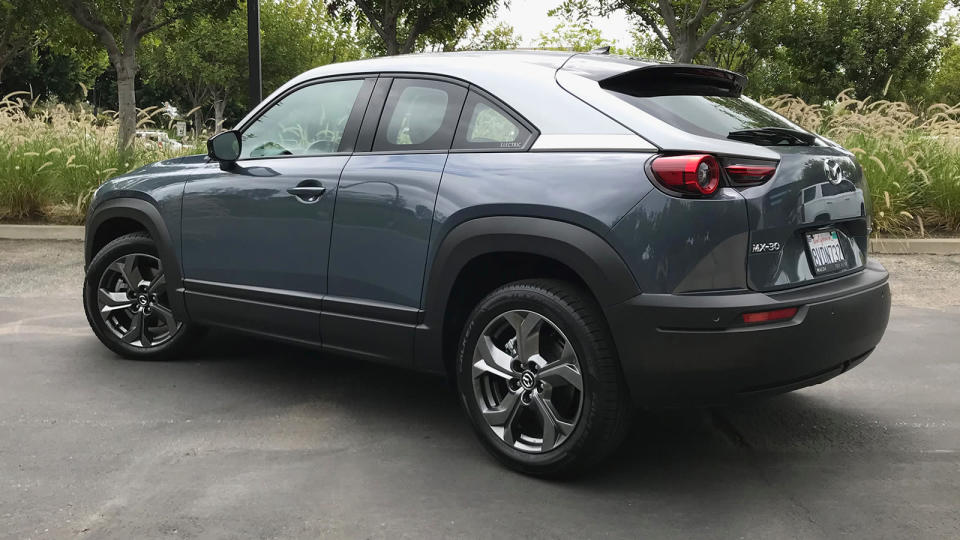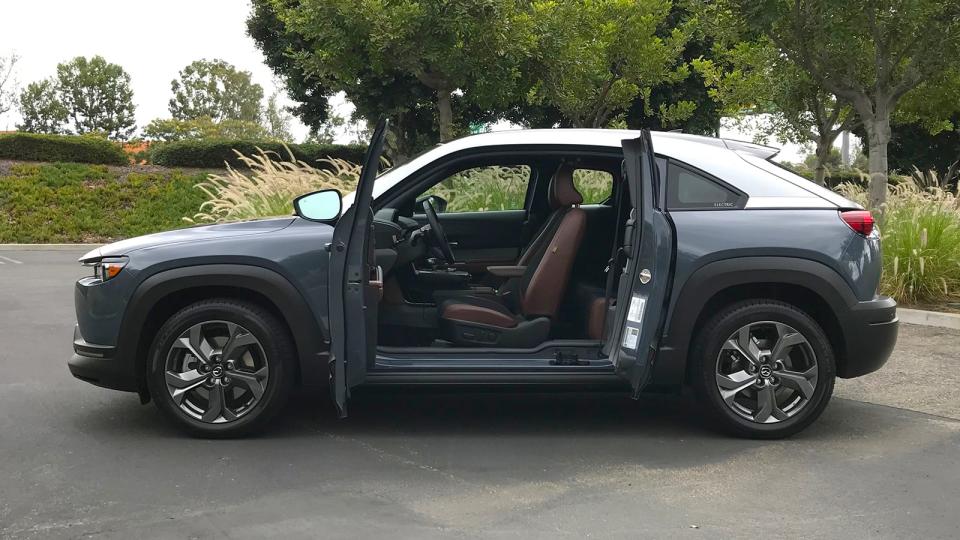2022 Mazda MX-30 First Drive Review | The right electric car for someone

Most new EVs boast ranges of 250 miles or more thanks to improved battery technology and the ability to stuff an awful lot of them in large, profitable cars and trucks. Unfortunately, most of those are pricey, starting at $40,000 or much more, and are more resource-intensive due to those big battery packs. The alternative is the handful of more economical options with just enough range for most situations, including the Mini Cooper SE, Hyundai Ioniq and 40-kWh Nissan Leaf, and now, the 2022 Mazda MX-30. It's the most pleasant car in this entry-level EV game thanks to its superior driving experience, interior quality, features and design, but the fact remains that its price is high for a small SUV and its limited 100-mile range will restrict it to a narrow niche of potential buyers.
The MX-30 is based on the same platform as the Mazda3 and CX-30. Its length and wheelbase are even nearly identical to the latter's. The suspension – MacPherson struts up front and a torsion beam in the back - is also the same design. Of course, the styling is radically different with a coupe-like roofline, rear-hinged half-doors for the back, and a square-jawed nose with a small grille. The distinctive contrasting roof and silver badging on the rear pillars are exclusive to the Premium Plus package.
Powering it is a single electric motor making 143 horsepower and 200 pound-feet of torque, which all goes to the front wheels via a single-speed transmission. Supplying power is a 35.5-kilowatt-hour gross battery pack that supplies those 100 miles of EPA-rated range.

And there's no getting around it, that range isn't good. It's one of the lowest of any EV on the market. Part of that is the relatively small battery size. And no, without some major improvement in power density, Mazda can't add additional capacity. Apparently it has filled the platform as full as possible, and any more batteries would have to be placed in risky locations or further compromise interior space. Another issue is that the MX-30 is not as efficient as other EVs. It gets a combined fuel economy equivalence of 92 mpg-e. The Mini Cooper SE, which has a slightly smaller battery, but gets 114 miles of range and has a fuel economy equivalence of 110 mpg-e. The competitively priced 149-mile Nissan Leaf and 170-mile Hyundai Ioniq also get their greater range from additional battery capacity and even better efficiency.
Mazda offers explanations for going with a small battery, and they have some merit. More batteries means more weight and more material cost, which are bad for driving dynamics and can be somewhat counter-intuitive to being more environmentally friendly. It's just not optimal for the market. At least Mazda seems to be aware of that, since it offers a couple things to help out with the range. It includes a $500 credit from ChargePoint that can be used to buy any Level 2 home charge point, or be put toward paying for public charging. Furthermore, Mazda includes three years of what's called the Mazda MX-30 Elite Access Loaner Program. This lets MX-30 owners borrow any other Mazda model for up to 10 days each year for long trips or trips that require more space. It's not restricted to a group of models, either, so you could hypothetically borrow a Miata just for the fun of it.
There's also the upcoming plug-in series-hybrid MX-30 slated for next year. It will use a tiny rotary engine to generate electricity when the battery pack is drained. This will allow it to travel farther without recharging, and give owners more flexibility about when and where they go in the car, since they won't be at the mercy of charging stations. This is just one way the MX-30 is reminiscent of the BMW i3, a low-range EV that offered a range-extender model equipped with a tiny engine. It too had rear-hinged half doors.

Moving past the range issues, there are quite a few things to like about the MX-30, a lot of which comes from the way the MX-30 drives. Since the MX-30 shares its underpinnings with the 3 and CX-30, it's no surprise that it drives like them, and that's great. Well, maybe it's a little surprising, since the weight distribution is basically the opposite of the gas cars with 40% at the front and 60% at the rear. It also weighs 3,655 pounds, or 421 more than a front-wheel-drive CX-30.
Like those other Mazdas, the chassis is stiff, body roll is mild and although the ride is a touch firm, its fantastic damping keeps the car composed and smooth over rough pavement. The steering is some of the best in the business with solid feedback, exceptional precision, and weighting that's light, but not too light. It's even aided by a faster-reacting electric version of Mazda's G-Vectoring Control, which now works while braking and accelerating because of the electric motor's regenerative braking capabilities. It even adds a tiny amount of acceleration to the inside wheel on corner exit (about 0.01g) in addition to slight braking of the outside wheel to help the car straighten out. The change isn't noticeable without testing back-to-back with a gas-powered Mazda, but it is interesting.
Hit the throttle, and power feels similar to the MX-30's gas-powered platformmates, and the numbers are in striking distance of the Hyundai Ioniq and the 40-kWh Nissan Leaf. What's intriguing about the MX-30 is the throttle tuning. Mazda highlights that the throttle was developed to provide a feeling more like that of an internal combustion car. Basically, the amount of power provided is stretched out a bit, rather than giving you all that torque instantly. And they're bang-on in creating that sensation. It also has the benefit of feeling like the power curve doesn't fall off as fast as in other EVs. Similarly, Mazda designed the regenerative braking to come on more smoothly, and, while it can be adjusted to be fairly strong, you can't quite do one-pedal driving. The MX-30 also uses brake-by-wire, which helps prevent strange brake feel as it blends regenerative and physical braking. It's firm, consistent and easy to modulate, but it feels artificial and doesn't provide as clear feedback.

 Yahoo Autos
Yahoo Autos 
